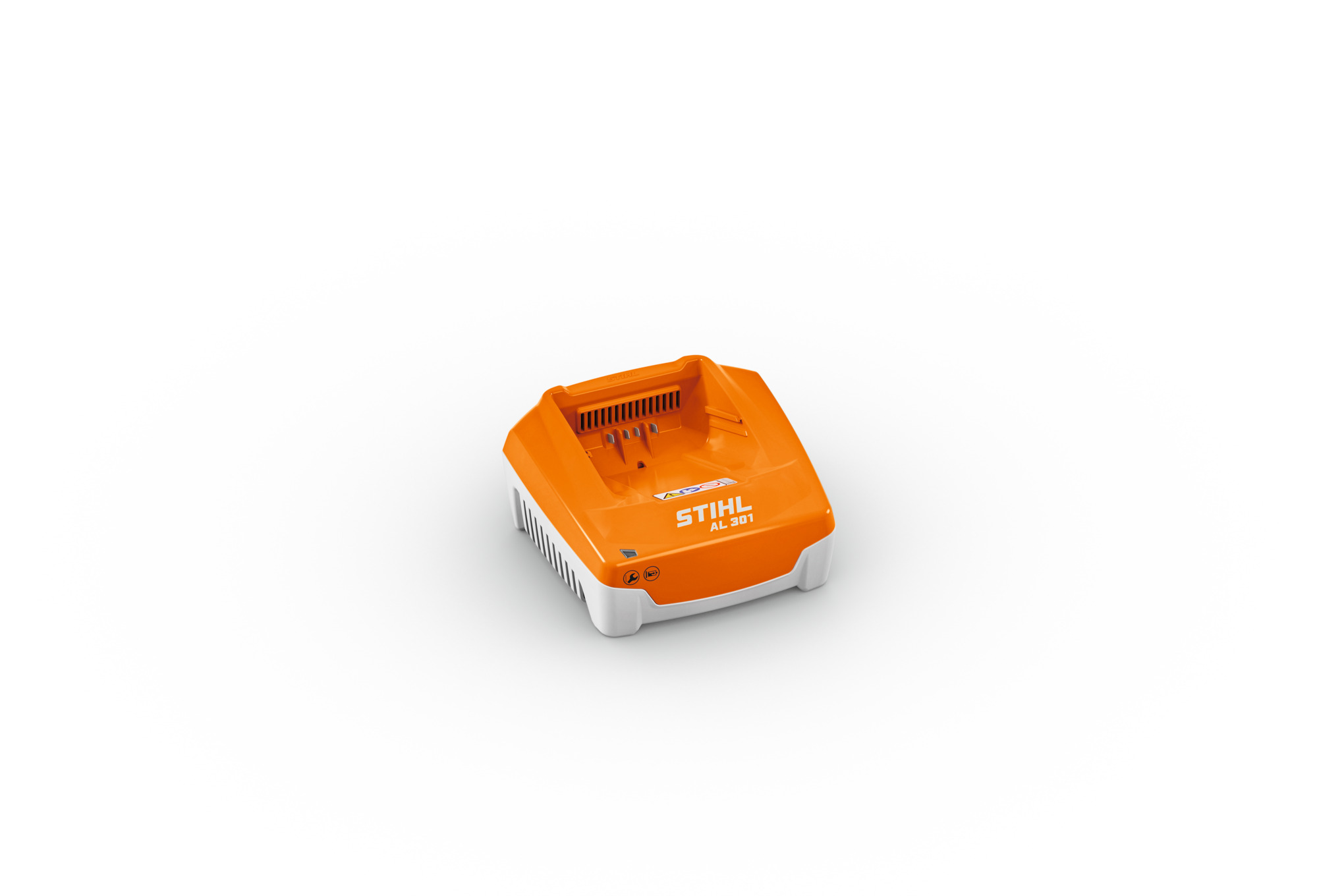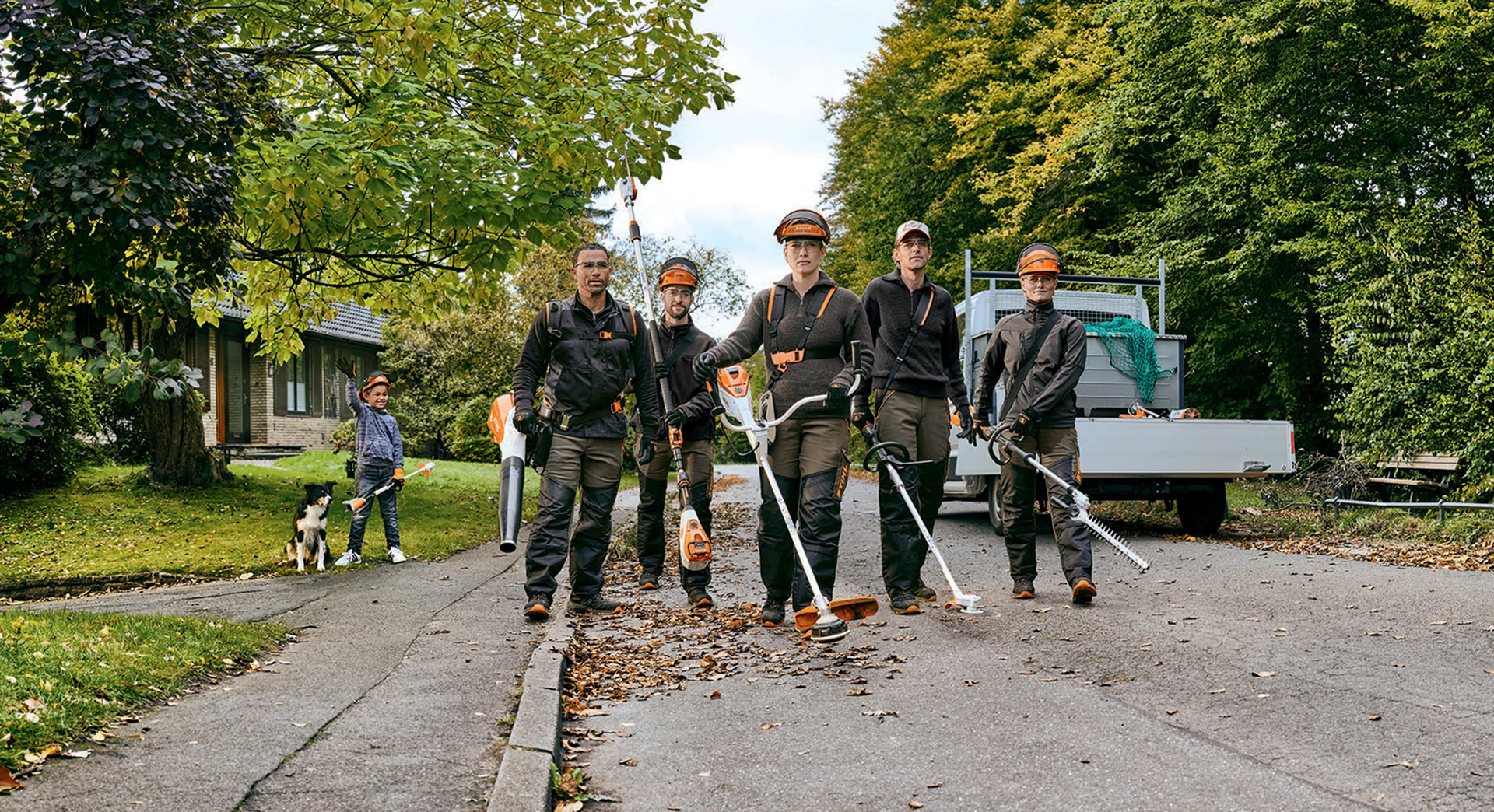Lithium-ion batteries – the basics
Developed in-house, our STIHL lithium-ion batteries are unique powerhouses for long-lasting power tools. Learn more about the world of lithium-ion batteries now.
09.10.2024
Lithium-ion batteries: structure and operation
To start, we have put together a brief overview of everything relating to the structure and functionality of lithium-ion batteries.

Electrons flow from the anode to the cathode by using the device.
Structure of lithium-ion batteries
A lithium-ion battery consists of many cells, each of which has two electrodes: a negative anode and a positive cathode. During discharge and charging processes, an electrolyte liquid conveys lithium ions between these two electrodes.
The electrodes are also electronically isolated by a separator to prevent a short circuit.

Electrons flow from the cathode to the anode by charging the battery.
How lithium-ion batteries work
When lithium-ion batteries are used, lithium ions and electrons are emitted on the anode side – a discharge process takes place. The lithium ions migrate through the electrolyte liquid and separator to the cathode, while the electrons flow through the outer circuit and perform electrical work. This process generates electromotive power, which drives the cordless power tool.
The procedure works in exactly the opposite way when charging the battery: the lithium ions now migrate from the cathode through the electrolyte liquid to the anode.
Lithium-ion batteries: Service life and durability
STIHL lithium-ion batteries are not disposable, but are in fact characterised by a particularly long service life and durability – a major advantage in terms of sustainability. When it comes to charging, lithium-ion batteries are suitable for up to 1,200 charging cycles. Thanks to the latest cell technology, the STIHL AP 500 S battery can even withstand up to 2,400 charging cycles.
The above-average service life of STIHL lithium-ion batteries reflects their special product quality. STIHL battery packs can also be used with many different STIHL cordless power tools – both older and newer power tool generations. Developed specifically for STIHL power tools, our battery packs not only offer enormous reliability, but are also a real long-term investment.
Lithium-ion battery capacity
Private users are not currently able to measure the battery capacity of lithium-ion batteries themselves. If you have any questions about your remaining battery capacity or notice a reduction in battery capacity, you can contact your nearest STIHL dealer for expert advice. STIHL battery dealers use a battery diagnostic tool to precisely determine the battery capacity. They can also help you with questions about battery life and charging times for STIHL batteries.
Deep discharge of lithium-ion batteries
You may have heard before that deep discharge, or the almost total discharge of a battery, can damage the battery. At STIHL, however, we rely on cutting-edge battery technology. The self-discharge of our lithium-ion cells is negligibly low – 1% to 3% per year, meaning that your STIHL battery is generally reliably protected against deep discharge.
We nonetheless recommend that you store lithium-ion batteries correctly. If the battery will not be used for more than a month, it should be kept at a charge level between 40% and 60% to prolong the life of the cells.
Lithium-ion batteries: temperature range
For optimum storage of our battery packs and to ensure long service life, we recommend storing them at an ambient temperature of approx. 20°C. This means that full performance is available even immediately after storage. In principle, it is possible to store battery packs within a temperature range of -20°C to +50°C, although functional and service life losses can be expected at the extreme ends of this range.
If anything is unclear, you can check the operating instructions for your battery; alternatively, our expert STIHL dealers will be happy to help.
Lithium-ion batteries: Disposal and recycling
Though they have a long service life, eventually your lithium-ion batteries will need to be disposed of or recycled. To ensure that you know exactly what to do with worn-out STIHL lithium-ion batteries, we have provided all the relevant information below.

Used batteries can be returned to a STIHL dealer.
Disposing of lithium-ion batteries
STIHL Limited has partnered with the RBRC to promote the collection and recycling of STIHL lithium-ion batteries in Canada. All STIHL batteries in Canada contain the RBRC seal, which indicates that STIHL has prepaid for battery recycling.
The RBRC toll-free phone number (1-800-822-8837) connects you to information on battery recycling locations and details on battery disposal bans or restrictions in your area. For more information on the RBRC, please visit Call 2 Recycle
Batteries must never be stored or transported loose and unprotected, but should always be protected against short circuit when being returned. To do this you can put the lithium-ion batteries either in the original packaging or in a plastic bag with poles covered over, or the batteries embedded in dry sand. Visit our service pages for more information on how to dispose of batteries and old electrical appliances.
Lithium-ion batteries: recycling
Recycling is indispensable for ensuring the responsible use of resources – and ensures that valuable components of lithium-ion batteries can be reused. There are wet chemical processes for recycling lithium-ion batteries: the batteries are collected, shredded, converted to black mass and electrochemically recovered.
Incidentally, because sustainability matters to all of us, STIHL plans to use more and more recycled and ethically sourced materials to produce its lithium-ion batteries in the future.
Memory effect
Concerns persist about a memory effect in batteries – but what’s the truth? The memory effect is a loss of capacity in nickel-cadmium batteries caused by early charging. If batteries of this kind are not completely discharged before they are recharged, they “remember” the energy requirements from the last charging processes and only use this amount of energy when charging, causing them to quickly lose capacity and become unusable.

However, this effect does not occur in STIHL lithium-ion batteries, which represent the cutting edge of battery technology.
Do you still have questions about technical matters? Read more about the memory effect in our guide.
Important questions and answers
Lithium-ion batteries are batteries that utilise the movement of lithium-ion and electrons between an anode and a cathode. An electrolyte liquid transports the lithium ions between the two electrodes during the discharging and charging processes. In addition, the electrodes are electronically isolated by a separator to prevent a short circuit.
Lithium-ion batteries consist of two electrodes, a negative anode and a positive cathode, as well as electrolytes and a separator.
Lithium-ion batteries work by transporting lithium ions through an electrolyte liquid within the battery cell. The movement of the ions and the electrons between the anode and cathode produces electromotive power.
STIHL lithium-ion batteries usually have up to 1,200 charging cycles, and in some cases even up to 2,400.
To produce lithium-ion batteries, all battery cells are moved into the correct position and, in the case of STIHL batteries, welded together using laser welding.
Lithium-ion batteries are used in a wide range of areas, including electric cars, e-bikes, smartphones, laptops and digital cameras. STIHL uses lithium-ion batteries in cordless power tools such as chainsaws, clearing saws and many other garden tools.
The question as to how dangerous lithium-ion batteries are and whether they can burn or explode due to crystalline deposits on the negative electrode arises time and again. In fact, the risk of fire is negligible, as STIHL batteries have been developed to the highest safety and quality standards.
There are wet chemical processes for recycling lithium-ion batteries: the batteries are collected, shredded, converted to black mass and recovered electrochemically.







